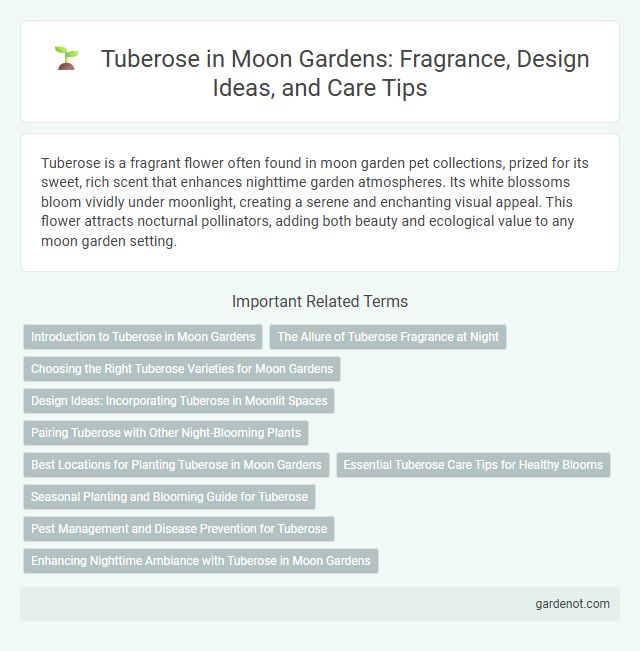Tuberose is a fragrant flower often found in moon garden pet collections, prized for its sweet, rich scent that enhances nighttime garden atmospheres. Its white blossoms bloom vividly under moonlight, creating a serene and enchanting visual appeal. This flower attracts nocturnal pollinators, adding both beauty and ecological value to any moon garden setting.
Introduction to Tuberose in Moon Gardens
Tuberose (Polianthes tuberosa) thrives in moon gardens due to its captivating, sweet fragrance that intensifies under moonlight, enhancing nighttime sensory experiences. This perennial bulb produces creamy white, star-shaped flowers that bloom in clusters, adding a soft, ethereal glow perfect for evening vistas. Tuberose prefers well-drained soil and partial to full sun, making it an ideal choice for creating serene, aromatic landscapes in moon garden designs.
The Allure of Tuberose Fragrance at Night
Tuberose emits a rich, intoxicating fragrance that intensifies under the moonlight, captivating the senses with its sweet, creamy notes. This nocturnal bloom releases its potent aroma primarily at night, making it a signature scent in moon gardens that thrive in evening ambiance. Its alluring scent not only enchants but also adds a mysterious, romantic atmosphere to nighttime landscapes.
Choosing the Right Tuberose Varieties for Moon Gardens
Selecting the right tuberose varieties for moon gardens enhances nighttime fragrance and visual appeal, with popular types like 'Double Pearl' offering dense, double blooms and strong scent perfect for evening enjoyment. Varieties such as 'Mexican Single' provide classic, elegant white flowers that radiate a sweet aroma under moonlight, making them ideal for creating a serene nighttime atmosphere. Focus on tuberose cultivars that thrive in your local climate and bloom profusely in late summer to ensure continuous fragrance throughout moonlit hours.
Design Ideas: Incorporating Tuberose in Moonlit Spaces
Tuberose thrives in moonlit gardens, emitting a rich, sweet fragrance that enhances nocturnal sensory experiences. Plant clusters of Tuberose along pathways or near seating areas to create fragrant focal points that bloom under the moonlight. Their tall, elegant stalks with white blossoms reflect soft moonlight, adding visual interest and a serene ambiance to nighttime garden design.
Pairing Tuberose with Other Night-Blooming Plants
Tuberose pairs exquisitely with other night-blooming plants such as night-blooming jasmine and evening primrose, creating a harmonious blend of intense fragrances that enhance moon garden ambiance. Combining Tuberose's rich, creamy scent with the sweet, citrusy notes of night-blooming jasmine attracts nocturnal pollinators like moths and enhances sensory experience after dusk. Planting Tuberose alongside angel's trumpet or night phlox cultivates a captivating nocturnal garden with complementary aromas and prolonged blooming periods under moonlight.
Best Locations for Planting Tuberose in Moon Gardens
Tuberose thrives in well-drained, fertile soils enriched with organic matter within moon gardens. Ideal planting locations include open areas receiving full moonlight or partial shade during the day, where the fragrant blooms can exude their scent effectively at night. Positioning tuberose near seating spaces or water features enhances the sensory experience, highlighting its aromatic presence under moonlit conditions.
Essential Tuberose Care Tips for Healthy Blooms
Tuberose thrives in well-drained, fertile soil with consistent moisture but should avoid waterlogging to prevent root rot. Providing full sun exposure for at least 6 hours daily enhances blooming and fragrance intensity. Regular deadheading and mulching improve air circulation and soil moisture retention, promoting robust flower growth and extended blooming periods.
Seasonal Planting and Blooming Guide for Tuberose
Tuberose thrives when planted in well-drained soil during late spring, after the last frost, ensuring optimal growth in warm temperatures between 70-85degF. This perennial bulb typically blooms from late summer to early fall, producing fragrant white flowers that peak in fragrance during the evening. Regular watering combined with full sun exposure accelerates tuberose flowering, making it a perfect seasonal choice for moon gardens.
Pest Management and Disease Prevention for Tuberose
Effective pest management for tuberose involves regular monitoring for common pests such as aphids, spider mites, and thrips, which can cause significant damage to the foliage and flowers. Implementing integrated pest management (IPM) strategies, including the use of insecticidal soaps, neem oil, and biological controls like ladybugs, helps maintain plant health without harming beneficial insects. Proper disease prevention includes ensuring good air circulation, avoiding overhead watering, and promptly removing infected plant material to reduce the risk of fungal diseases like leaf spot and rust.
Enhancing Nighttime Ambiance with Tuberose in Moon Gardens
Tuberose emits a rich, intoxicating fragrance that elevates the nighttime ambiance of moon gardens by casting a soothing and mystical aura under moonlight. Its creamy white blooms reflect moonbeams, creating visual contrast and enhancing the garden's ethereal beauty during the night. Incorporating tuberose in moon gardens not only attracts nocturnal pollinators but also fosters a serene atmosphere perfect for evening relaxation and contemplation.
Tuberose Infographic

 gardenot.com
gardenot.com